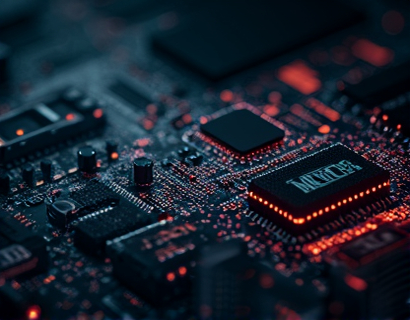Next-Gen Smart Contract AMMs: Revolutionizing DeFi Trading
In the rapidly evolving world of decentralized finance, or DeFi, the integration of advanced smart contract-based Automated Market Makers (AMMs) is transforming the landscape of trading. These innovative platforms leverage the power of blockchain technology to provide a more efficient, transparent, and automated trading experience. This article delves into the intricacies of next-generation smart contract AMMs, exploring how they optimize liquidity management and automate trading strategies, ultimately enhancing the overall DeFi trading experience.
Understanding Smart Contract AMMs
Traditional AMMs rely on algorithms to determine asset prices and manage liquidity pools, eliminating the need for order books and centralized exchanges. Smart contract AMMs take this a step further by utilizing blockchain's inherent transparency and immutability. These contracts are self-executing and automatically enforce the terms of the trading agreements, ensuring trustless and decentralized market interactions.
The core mechanism of a smart contract AMM involves liquidity pools, where users deposit pairs of tokens. These pools serve as the trading venue, and the smart contract manages the exchange of tokens based on predefined formulas. The most common formula used is the Constant Product Market Maker (CPMM) model, where the product of the quantities of two assets in a pool remains constant, ensuring liquidity and price stability.
Advanced Automation in AMMs
One of the most significant advancements in next-gen AMMs is the integration of sophisticated automation features. These features enable traders to set and execute complex trading strategies without manual intervention. For instance, users can create automated market makers (AMMs) that dynamically adjust to market conditions, optimizing liquidity and maximizing returns.
Smart contracts can be programmed to execute arbitrage opportunities automatically, capitalizing on price discrepancies across different DeFi platforms. This not only enhances liquidity but also ensures that traders can benefit from market inefficiencies in real-time. Additionally, automated rebalancing mechanisms can be implemented to maintain optimal asset ratios in liquidity pools, further enhancing the efficiency of the trading process.
Liquidity Management Innovations
Effective liquidity management is crucial for the success of any DeFi platform. Next-gen smart contract AMMs introduce advanced tools and protocols to manage liquidity more effectively. One such innovation is the use of liquidity provision incentives, where users are rewarded with governance tokens or other incentives for providing liquidity to pools. These incentives are often dynamically adjusted based on market conditions, ensuring that liquidity providers are compensated fairly and encouraged to maintain their positions.
Another key feature is the implementation of liquidity wrappers, which allow users to deposit and withdraw assets seamlessly without exposing their private keys. This enhances security and user experience, as users can manage their liquidity without directly interacting with the smart contract. Furthermore, cross-chain liquidity protocols enable users to provide liquidity across multiple blockchain networks, expanding the reach and utility of their assets.
Enhanced Trading Strategies
The automation capabilities of next-gen smart contract AMMs open up a myriad of advanced trading strategies. One such strategy is the use of algorithmic trading bots, which can execute trades based on predefined criteria such as price movements, volume, and market sentiment. These bots can operate 24/7, ensuring that trading opportunities are captured in real-time without human intervention.
Another advanced strategy is the implementation of yield farming, where users deploy their assets to various DeFi protocols to earn passive income. Smart contract AMMs can automate the process of reallocating assets between different yield-generating opportunities, maximizing returns and minimizing risk. This dynamic asset allocation is particularly beneficial in a volatile market environment, where quick adjustments can lead to significant financial gains.
Security and Trustlessness
Security is a paramount concern in the DeFi space, and next-gen smart contract AMMs are designed with robust security features to protect user assets. The use of formal verification and audits by reputable security firms ensures that smart contracts are free from vulnerabilities and bugs. Additionally, the decentralized nature of blockchain technology eliminates the risk of single points of failure, providing a higher level of trust and security compared to traditional centralized exchanges.
The trustless mechanism of smart contracts means that all transactions are verified and executed by the network, without the need for intermediaries. This not only reduces transaction costs but also ensures that all participants are on equal footing, fostering a more democratic and transparent trading environment.
User Experience and Accessibility
Despite the complexity of smart contract AMMs, next-gen platforms are designed to provide an intuitive and user-friendly experience. Advanced user interfaces and dashboards allow traders to monitor their liquidity positions, trading history, and portfolio performance in real-time. These interfaces are often accompanied by educational resources and tutorials, helping new users understand and leverage the full potential of DeFi trading.
Moreover, the integration of wallet compatibility and cross-platform support ensures that users can access these advanced AMMs from various devices and ecosystems. This accessibility is crucial for broadening the adoption of DeFi and making it available to a wider audience, including those with limited technical expertise.
Future Prospects and Challenges
The future of smart contract AMMs in DeFi is promising, with ongoing developments aimed at addressing current challenges and enhancing functionality. One area of focus is the improvement of user onboarding and education, making DeFi more approachable for mainstream users. Additionally, the integration of more complex financial instruments and derivatives can expand the range of trading opportunities available on these platforms.
However, challenges such as scalability, gas fees, and regulatory uncertainties remain. The development of layer 2 solutions and interoperability protocols is essential to address scalability issues, while community-driven initiatives and regulatory engagement can help navigate the complex legal landscape.
Conclusion
Next-gen smart contract AMMs are at the forefront of DeFi innovation, offering a powerful combination of advanced automation, liquidity management, and secure trading. By leveraging these technologies, crypto traders and DeFi enthusiasts can experience a more efficient, transparent, and rewarding trading environment. As the ecosystem continues to evolve, the potential for further advancements and broader adoption remains immense, paving the way for a decentralized financial future.











































